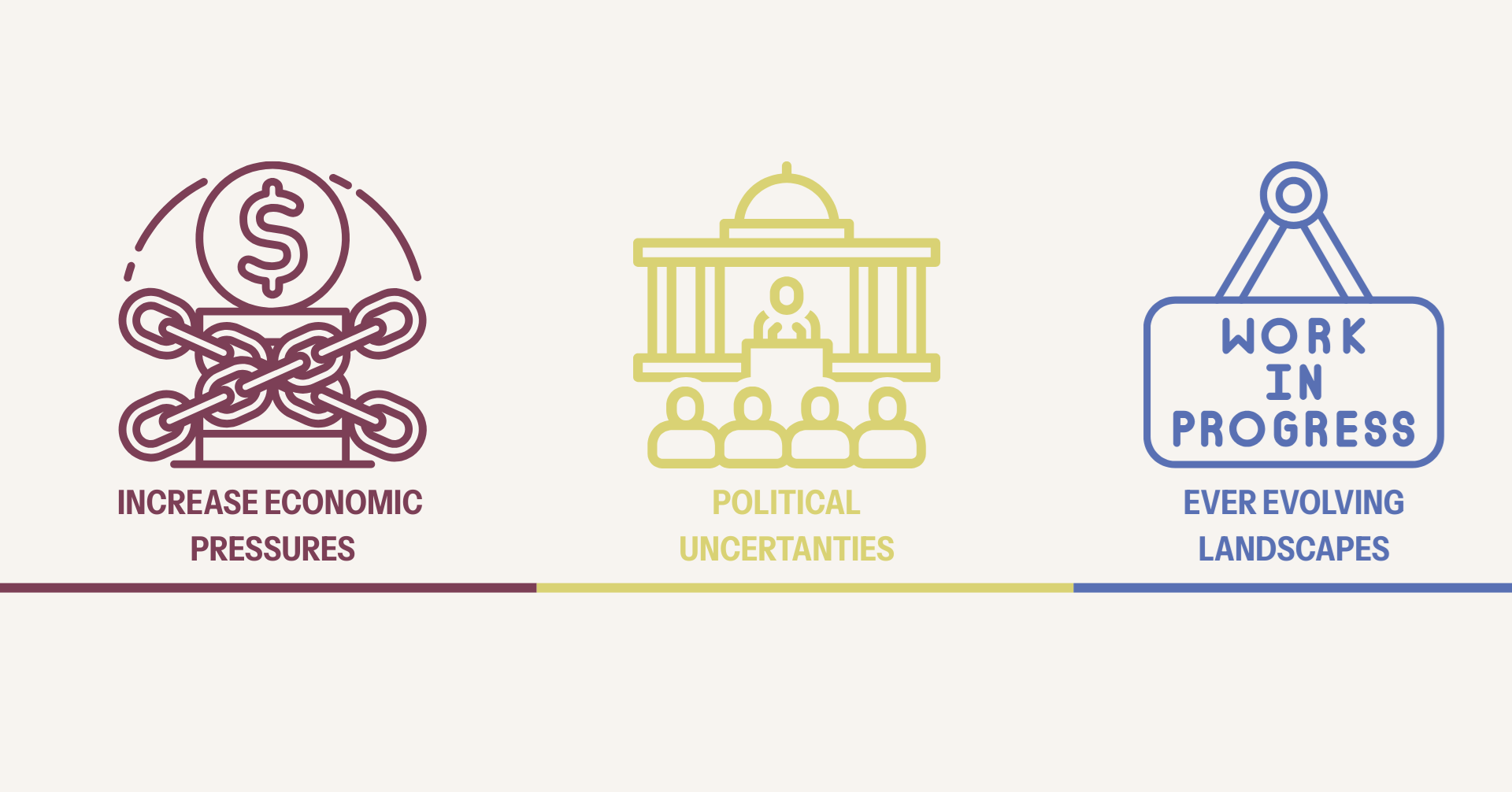You’re not alone if your organization has faced a recent organizational change.
Funding shifts, federal policy changes, and economic uncertainty have forced many mission-driven organizations to make hard choices. For many mission-driven organizations, the majority of the budget goes to staff salaries and benefits. That means that when funding is disrupted, staff are often the first to be impacted.
It can be a painful place to be, but it can also be a turning point. The restructuring process can be more than just surviving; it can be an opportunity to strategically realign your people-systems around clarity, sustainability, and equity, strengthening both the efficiency and impact of the organization.
Why Realignment Matters After a Restructure
When roles shift or entire teams are consolidated, leaders are left with critical questions:
- How do we redesign our job families to reflect the work that actually needs to get done?
- Are we paying people equitably in their revised or new roles?
- How do we ensure our decisions are financially responsible and aligned with our mission?
If decisions aren’t grounded in a strategic, long-term restructuring plan, organizations risk repeating the same painful adjustments multiple times. Multiple rounds of downsizing or changes create fear and instability, eroding both culture and employee engagement.
However, with a deliberate approach, you can rebuild the organizational structure in ways that strengthen it, rather than weaken it. This kind of strategic restructuring allows for adaptability, helping organizations respond to external factors without losing sight of equity or values.
While reorganization is never easy, following a thoughtful process can make the experience more transparent, equitable, and sustainable—here’s how to begin.
Step 1: Start With a Financial Risk Assessment
Before you redraw job charts or update pay scales, take a step back. Conduct a financial risk assessment to clarify:
- How diverse is your funding mix and your program portfolio? If one service or revenue stream were to disappear, how exposed would your organization be?
- Where are your high, medium, and low risks over the next 2–3 years?
- What macro trends (in your sector, in the economy) could impact your sustainability?
From there, create realistic financial scenarios—not just best case or worst case, but what’s most likely to happen. Without this, you risk making cuts or changes that aren’t sustainable, which can force you into repeated restructures. Each new round makes the problem bigger, fueling instability and creating fear across the organization.
Tools to Strengthen Your Restructuring Plan
→ Use Edgility’s Funding Risk Assessment tool to map your exposure across key funding streams.
→ Watch the Risk to Resilience Webinar for a deeper dive on scenario planning and how to prepare your organization for disruption.

Funding Risk Assessment: A framework for evaluating risk based on funder diversity, funding channels, restrictions, relationship stability, and benchmark dependency. This framework helps organizations assess funding stability by examining donor diversity, restrictions, relationships, and benchmarks to identify potential risks.
Step 2: Redesign Job Families for the Future
A restructure is the right moment to revisit your job family framework—the levels of roles, their scope of responsibility, and management expectations.
That process should include:
- Clarifying job roles and responsibilities in updated job descriptions so staff know what’s expected in the new structure.
- Aligning the work chart to your financial scenarios: Did you consolidate regions? Shift programs? Reshape reporting lines? Job families should mirror these choices.
- Determining the scope of change: If only 10% of roles are shifting, updating descriptions may be sufficient. But if you’re reimagining large portions of your organization, you’ll need to rebuild the structure and benchmark those jobs against the market.
By grounding job families in both organizational design and market reality, you create a structure that is clear, equitable, and sustainable for the future. This sets the foundation for a successful restructuring that avoids inefficiencies and supports long-term strategic objectives.
Step 3: Conduct a Market Analysis and Set Pay Scales
After a restructure, compensation benchmarks must be revisited. Roles may look different, and relying on outdated pay data can create inequities. A fresh market analysis helps you:
- Re-benchmark revised roles against the market to understand current salary expectations and anticipate what those roles will cost your organization in the future."
- Be clear about whether significantly changed roles will be opened internally, externally, or both.
- Invest in professional development so staff can step into new responsibilities with confidence.
Step 5: Communicate With Humanity and Transparency
Restructuring impacts people deeply, and effective communication must be handled with care:
- Share updates quickly to prevent speculation.
- Inform affected staff and their managers, then communicate to the broader organization.
- Provide managers with FAQs and clear talking points—both for internal and external audiences—so they can confidently answer the question every staff member will ask: "What does this mean for me?'"
- Train managers thoroughly—many are navigating this for the first time and need support to communicate well.
- Make space for staff to ask questions, and acknowledge and celebrate those who are leaving.
Above all, honesty matters. Staff will ask, “Will there be salary cuts? Will there be raises? Could I be next?” Even though you cannot predict the future and commit to never having to downsize again, sharing what you can now will help to alleviate concerns, build trust, and credibility.

Step 6: Center Equity and Values in Every Decision
Restructuring decisions are financial, but at their core, they are people decisions. Equity and humanity must guide the process:
- Apply consistent processes across all staff to ensure fairness. For example, if roles are being reclassified, the same framework should be used consistently, rather than being adjusted on a case-by-case basis.
- Provide transition support for those impacted—whether that’s extended notice or job search support and resources.
- Anchor every decision in your mission and values, so even in moments of contraction, your organization is living what it stands for.
Together, these actions show that even during large-scale reorganization or layoffs, a successful organization remains committed to fairness.
From Reorganization to Renewal
Restructuring is never easy, but it doesn’t have to leave lasting scars. When approached with foresight, clarity, and equity, it can become a reset that builds resilience.
By grounding your restructuring plan in financial risk assessments, job family redesign, market-informed compensation, equitable talent evaluation, transparent communication, and values-based decision-making, you not only manage change responsibly—you reinforce the culture of trust and care that sustains your mission.
If you’re ready to go deeper, explore our eBook Compensation with Purpose: Designing Equity-Centered Pay Structures for Nonprofits, Education, and Healthcare. It unpacks how to design pay systems that align with your mission and values while staying competitive in today’s market.
Frequently Asked Questions About Organizational Restructuring and Compensation
Q1: Why is realignment important after a restructure?
A: After organizational change, job roles and responsibilities often shift. Without realignment, organizations risk confusion, inequities, and repeated cuts. Realigning roles, job families, and pay structures ensures clarity, fairness, and long-term sustainability.
Q2: What is a financial risk assessment, and why does it matter?
A: A financial risk assessment helps mission-driven organizations map out how diverse their funding is and anticipate high, medium, or low risks over the next 2–3 years. It provides the foundation for scenario planning, helping leaders avoid unsustainable cuts that erode trust.
Q3: How do job families support a successful restructuring?
A: Job families define levels, responsibilities, and management expectations across an organization. Updating them during reorganization ensures consistency, prevents inefficiencies, and makes it easier to benchmark pay fairly against the market.
Q4: Why revisit pay scales after restructuring?
A: Restructuring often changes roles significantly. Market analysis ensures salaries reflect those changes and prevents inequities. It also helps organizations balance external benchmarks with internal value and equity priorities.
Q5: How should staff be evaluated in new roles?
A: Consistency is key. Use the same data sources—such as resumes, performance evaluations, and prior experience—for all staff. Invest in professional development to help employees adapt to new responsibilities or technologies.
Q6: What role does communication play in the restructuring process?
A: Effective communication is essential. Inform affected staff and their managers first, provide managers with FAQs and talking points, and be honest about what the changes mean. Transparency and empathy build credibility, even during difficult moments.
Q7: How can organizations anchor restructuring decisions in values?
A: Successful organizations apply equity and consistency across all staff, support those impacted with extended notice or job search resources, and explain not only what is changing but why. This ensures decisions reflect the mission and values of the organization.
Q8: Where can leaders find tools to support this process?
A: Edgility offers resources such as:
- The Funding Risk Assessment and the Risk to Resilience Webinar
- The eBook Compensation with Purpose: Designing Equity-Centered Pay Structures for Nonprofits, Education, and Healthcare. These tools provide clarity and strategies for building equity-centered systems.
Do you want support realigning your job families and compensation framework after restructuring? Schedule a discovery consultation with Edgility Talent Partners.






